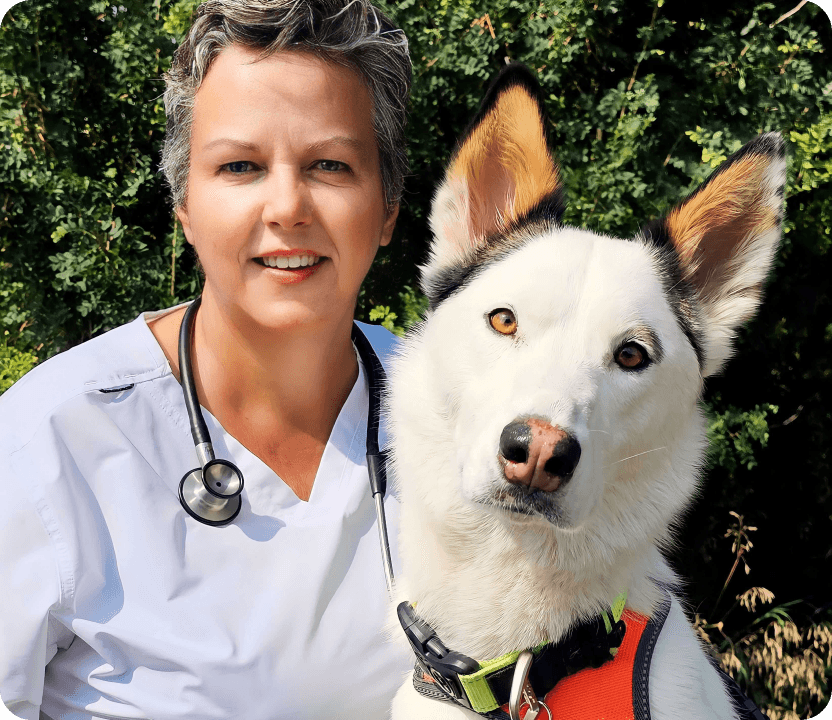As a dog owner, it can be extremely upsetting to watch your pup constantly scratch, bite, and whimper in discomfort. In many cases, this is caused by an allergy.
Dogs can be allergic to something in their environment or diet, and they can also be allergic to fleas. An overactive immune response to the bite of a flea can lead to itchy skin as well as redness, hair loss, and secondary infection.
This in-depth guide aims to shed light on the complex nature of flea allergies in dogs, from information about the flea life cycle to common symptoms and treatment recommendations.
Key facts:
- Flea allergy dermatitis is an allergic reaction to the saliva of fleas.
- A single flea bite is enough to cause significant clinical signs in allergic dogs.
- Symptoms of flea allergy dermatitis include severe itching (pruritus), redness, inflammation, hair loss, and skin infections due to excessive scratching and biting at the skin.
- It is common for dogs with flea allergies to also have food or environmental allergies.
- Your veterinarian can diagnose flea allergy dermatitis by performing a thorough physical examination while also considering the pet’s history and symptoms. They may also perform skin tests to rule out other issues and identify secondary infections.
- Treatment of flea allergy dermatitis involves a three-pronged approach – eliminating fleas on all pets in the household, killing fleas in the environment, and providing treatment for skin infections and itchy skin.
- Regular use of effective flea control products on all pets in the household is essential for preventing flea allergies in dogs.

What are flea allergies in dogs?
The most common type of flea seen on dogs is actually the cat flea, Ctenocephalides felis. While fleas can cause itching and discomfort in any dog, some dogs are allergic to the flea’s saliva, which is injected into their skin when a flea takes a blood meal.
With a dog flea allergy, the immune system perceives proteins in the flea saliva as threats. In response to the threat, the immune system releases chemicals like histamines that lead to skin inflammation and intense itching.
This itching then prompts the dog to scratch or bite the area, causing further inflammation and damage to the skin. These symptoms and impacts on the skin are collectively known as flea allergy dermatitis, or “FAD” for short.
Flea allergies can be seen in any breed, age, or sex of dog. It is important to note that dogs who are allergic to fleas may also have other types of allergies as well. For more information on dog allergies, see our complete guide here.
Symptoms of flea allergy dermatitis
Dogs with FAD often have the following symptoms:
- Severe pruritus (itchy skin): This is the most common and often the first sign. Dogs will chew, scratch, and lick excessively, which results in damage to the skin.
- Skin lesions and secondary infection: Scratching and skin damage lead to redness, hair loss, pustules (pimples), papules (red bumps), oozing, scales, and scabs.
- Hot spots: In some cases, dogs may develop moist, raw, inflamed, painful areas of skin acute known as hot spots.
- Skin lesions are most commonly seen on the lower back, base of the tail, and thighs, although all areas of the body may be affected.
- Live fleas or flea dirt are not always seen. Flea dirt (flea feces) appear as small black specks that turn red when placed on a damp white tissue due to the presence of digested blood.
- Fleas and symptoms of FAD can occur year-round, even in colder climates.
Diagnosing flea allergy in dogs
While not a medical emergency, flea allergies in dogs can cause significant discomfort and distress. Therefore, if you suspect your dog has a flea allergy, a veterinary exam is recommended as soon as possible.
Your veterinarian will likely begin with a thorough physical examination and detailed history. They will take note of clinical signs like intense itching, skin inflammation, and typical locations of lesions which can suggest FAD. A flea comb can help find fleas or flea dirt on your dog’s coat. Rarely, intradermal testing might also be utilized to identify other possible allergies. A positive response to flea treatment also suggests FAD.
Your veterinarian may recommend additional tests, such as skin scrapings, bacterial or fungal cultures, or skin biopsies, to rule out other skin conditions which appear similar to FAD.
Lastly, cytology can help identify secondary bacterial or yeast skin infections as well as guide treatment recommendations. This test involves collecting a sample of cells from the skin by using tape, a swab, or a glass slide, and examining them under the microscope.
Understanding the flea life cycle
Before we can discuss the treatment and prevention of flea allergies, it’s important to understand the flea life cycle – mainly that the majority of it occurs not on your dog but in your home. Here’s what happens:
- An adult flea finds a host (typically a pet) and starts to feed on its blood. Once the female flea has fed, she begins to lay up to 50 eggs per day.
- Flea eggs fall off the host and scatter in the environment (your home).
- The eggs hatch in 1 to 6 days. The flea larvae move deep into carpets, under furniture, or soil to avoid light, feeding on adult flea feces and other organic debris in their environment
- After 1-2 weeks, the larvae spin cocoons and enter the pupal stage. Inside the cocoon, the flea develops into an adult. The pupae can survive in this stage for up to a year, waiting for optimal conditions to emerge.
- The adult flea emerges from the cocoon when it senses warmth, carbon dioxide, or vibrations, indicating a host is nearby. Once the adult flea finds a host and begins feeding, the female begins to lay eggs within 24-48 hours, and the cycle repeats.

How to treat dogs with flea allergy dermatitis
There are three key components to treating flea allergies in dogs, including:
- Treating itchy skin and secondary skin infections.
- Using year-round flea prevention for all pets in the household.
- Treating your house and yard for fleas, if necessary.
Let’s explore some of the options for managing FAD in your dog:
Itch control
Corticosteroids or newer medications, such as Apoquel® (oclacitinib), are extremely effective at decreasing inflammation and itchy skin associated with FAD and can provide almost immediate relief for your dog. It may also be important for your dog to wear an E-collar (cone) to prevent additional chewing and licking of the skin until symptoms are under control.
Antibiotics or antifungals
The itching and scratching caused by FAD can lead to skin damage and secondary skin infections. Treating these infections is an important part of managing FAD.
These medications may be given by mouth to treat severe infections. Medicated shampoos, ointments, and wipes containing antibacterial and antifungal properties are also an excellent way to treat milder or localized skin infections and also to calm inflammation of the skin.
Flea control
There are many different options available for flea control for pets. While some are available over-the-counter, the safest and most effective treatments require a prescription from your veterinarian. It is best to talk to your veterinarian about their recommendations based on your dog’s needs and lifestyle.
Some products are in the form of a liquid that is applied to the skin on the back of the neck, while others come as a flavored tablet or a medicated collar. Many also protect against other types of parasites, including certain intestinal worms, mites, lice, ticks, and heartworm disease.
As fleas can easily spread from one animal to another, it is extremely important to have all pets in your household on flea treatments year-round. It can take up to 3 months of consistent effort to get rid of fleas.
Products to treat your home
Now that you’re familiar with the flea life cycle, you can see why it is important to treat your home as well as your pets for fleas. In cases of severe flea infestation, this involves frequent vacuuming, washing bedding in hot water, and the use of products such as Fleabusters® (borate powder).
Managing a dog with flea allergies
If your dog has been diagnosed with FAD, be sure to follow your veterinarian’s treatment plan and take these steps to resolve itch/infection and also help prevent future flare-ups.
- Use year-round flea prevention – Use flea treatments recommended by your veterinarian to protect your pup from fleas year-round.
- Treat all pets in the household – If you have multiple pets, make sure that they are all on flea prevention, as fleas can easily spread from one animal to another.
- Treat secondary skin infections and itchy skin – This may involve topical or oral antibacterial or antifungal medications, depending on if the infection is caused by yeast or bacteria. Medications to calm itchy skin, such as corticosteroids or Apoquel®, may also be prescribed by your veterinarian.
- Regularly groom and inspect your dog for signs of fleas or flea dirt – You may use a gentle oatmeal shampoo or medicated product for bathing.
- Maintain a clean environment – Regularly clean your home, paying special attention to areas your dogs frequents. Vacuum carpets, wash bedding, and clean furniture to remove any flea eggs or larvae.
- Treat your home and yard – Use a product such as Fleabusters® to kill flea eggs and larvae in the environment, ideally once a year. In addition, be sure to avoid contact with wildlife and areas known to be flea-infested.
- Feed a nutritious diet – An AAFCO and WSAVA-approved complete and balanced diet can help keep your dog fit, support their immune system, and maintain a healthy skin barrier.
- Add supplements for skin health – Supplements such as omega-3 fatty acids (found in fish oil) can help support your dog’s skin barrier and decrease symptoms of allergies. Probiotics help keep your dog’s gut healthy and may also have positive effects on the skin.
- Respond quickly to symptoms – Even in dogs with well-controlled allergies, flare-ups are possible. If your dog begins to show symptoms of flea allergies, such as excessive scratching or biting, respond quickly and contact your veterinarian. The faster you act, the quicker you can provide your dog with relief and prevent secondary infections.
- Manage other allergies – Dogs with flea allergies often have allergies to other things in the environment (atopy) or the protein source in their diet (food allergies). Your veterinarian can help you develop a treatment plan to address these other allergies.
Final words on flea allergies in dogs
Flea allergy dermatitis is one of the most common skin conditions affecting dogs and can also be one of the most frustrating to manage. It can cause severe itching, discomfort, and skin problems for dogs, and negatively affects the quality of life for both the dogs and their owners.
Fortunately, once the problem is recognized, it is possible to effectively manage this condition and provide lasting relief. Advances in allergy management and flea treatment products in recent years have made it easier than ever before to protect against flea allergies in dogs.
The best way to prevent flea allergy dermatitis is through prevention and early detection. Talk to your veterinarian about the best flea products for your dog and make sure to stay up-to-date on their monthly treatments.
Additionally, if you notice any signs of itching or skin irritation, bring your dog to the vet for a check-up. With prompt action, you can keep flea allergies from becoming a major problem in your pet’s life and relieve their discomfort.
Flea allergy FAQs
I don’t see any fleas on my dog – how can they have a flea allergy?
Dogs who are allergic to fleas can have a significant reaction to the bite of even a single flea. In some cases, you may see fleas or flea dirt on your dog, but their absence does not rule out FAD.
How do I tell the difference between a flea allergy and a flea infestation?
Fleas can cause itching and discomfort in any dog, but a dog who is allergic to fleas will develop a significant reaction from the bite of just a single flea. Additionally, their symptoms tend to be much more severe. The treatment for flea infestation is similar in that it also involves treating any secondary skin infections and itchy skin, using flea prevention on all pets in the household for at least 3 months (the necessary amount of time to break the flea life cycle), and treating the environment for fleas. Your vet will be an important resource if you are dealing with fleas.
Can I treat flea allergy dermatitis at home?
In most cases, veterinary treatment is needed to address FAD. This is because prescription antibiotics and anti-inflammatories are often needed to manage skin infection. Furthermore, while there are many over-the-counter products marketed as flea prevention, the most effective (and safest) products require a prescription from your veterinarian.
When should I see a vet for flea allergies?
Flea allergies are not an emergency; however, they can cause intense itching, discomfort, and frustration (to dogs and pet parents alike). It is best to schedule an appointment as soon as possible to help manage itchy skin, treat any secondary skin infections that are present, and start an appropriate flea preventative.
How often should I apply flea prevention to my dog?
There are several options for flea prevention available, including topical products that are applied to the skin between the shoulder blades, pills given by mouth, and medicated collars. Your veterinarian will be able to help recommend a product based on your dog’s lifestyle and your needs. Many products need to be given or applied monthly, but some are longer lasting. Whichever one you choose, be sure to mark it on your calendar to avoid forgetting any doses.
Are certain breeds more predisposed to flea allergies?
FAD can be seen in any age, breed, or sex of dog. However, it is most common in dogs over 6 months of age. Certain breeds that are more prone to allergies in general, such as Golden Retrievers, Labrador Retrievers, Terriers, and Cocker Spaniels, to name a few, may also be more likely to develop flea allergies.
Sources:
https://entnemdept.ufl.edu/creatures/urban/occas/catflea.htm
https://pubmed.ncbi.nlm.nih.gov/19517416/
https://pubmed.ncbi.nlm.nih.gov/16325922/
https://www.vin.com/apputil/content/defaultadv1.aspx?meta=Generic&pId=11242&id=3860736








